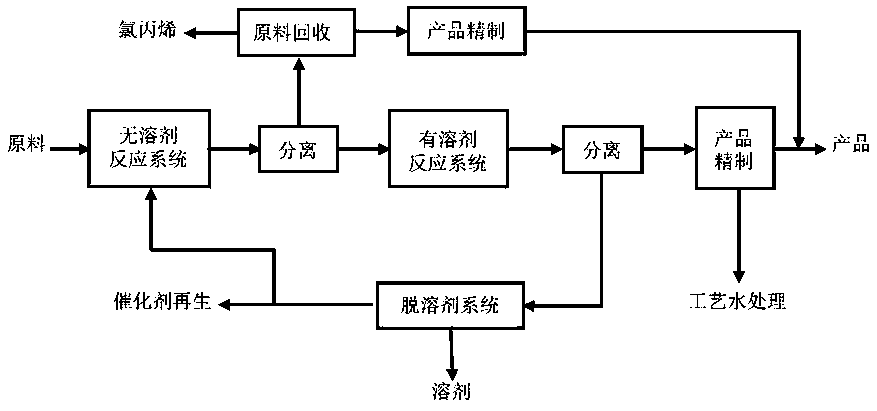Sectional production method of epichlorohydrin
A technology for epichlorohydrin and a production method, applied in chemical recovery, organic chemistry and other directions, can solve the problems of low utilization rate of raw materials, improved product yield, low reaction efficiency, etc. The effect of reducing the amount and improving the production efficiency
- Summary
- Abstract
- Description
- Claims
- Application Information
AI Technical Summary
Problems solved by technology
Method used
Image
Examples
Embodiment 1
[0028] The solvent-free reaction system of this embodiment adopts a two-stage reaction method, including a first-stage reactor and a second-stage reactor; the solvent-containing reaction system adopts a one-stage reaction method. See figure 1 Given a schematic diagram of the process flow of the present invention, the process of the present invention includes the following steps:
[0029] Add chloropropene, hydrogen peroxide, titanium silicon catalyst, and pH adjuster to the first stage reactor of the solvent-free reaction system in the following proportions. Among them, hydrogen peroxide is an aqueous hydrogen peroxide solution with a mass concentration of 50%. The molar ratio of chloropropene to hydrogen peroxide is 3, the mass of the titanium-silicon catalyst accounts for 5% of the total mass of the reaction raw materials, ammonia water is used as the solution pH regulator to adjust the pH of the solution to 3, and the reaction temperature is controlled to 40°C and the pressure...
Embodiment 2
[0036] The solvent-free reaction system of this embodiment adopts a two-stage reaction method, including a first-stage reactor and a second-stage reactor; the solvent-containing reaction system adopts a one-stage reaction method. See figure 1 Given a schematic diagram of the process flow of the present invention, the process of the present invention includes the following steps:
[0037] Add chloropropylene, hydrogen peroxide, applied titanium silicon catalyst, fresh titanium silicon catalyst, and pH adjuster into the first stage reactor of the solvent-free reaction system in the following proportions. The concentration of hydrogen peroxide in the hydrogen peroxide aqueous solution is 50% , The molar ratio of chloropropylene to hydrogen peroxide is 3, the mass of the titanium-silicon catalyst accounts for 5% of the total mass of the reaction raw materials, and the mass ratio of the applied titanium-silicon catalyst to the fresh titanium-silicon catalyst is 7:3, and ammonia is use...
Embodiment 3
[0044] The solvent-free reaction system of this embodiment adopts a one-stage reaction method, and the solvent-containing reaction system also adopts a one-stage reaction method. See figure 1 Given the process flow diagram of the present invention, the process includes the following steps:
[0045] Add chloropropylene, hydrogen peroxide, applied titanium silicon catalyst, fresh titanium silicon catalyst, and pH adjuster into a reactor of the solvent-free reaction system according to the following proportions. The concentration of hydrogen peroxide in the aqueous hydrogen peroxide solution is 50%. The molar ratio of propylene to hydrogen peroxide is 3, the mass of the titanium-silicon catalyst accounts for 5% of the total mass of the reaction raw materials, and the mass ratio of the titanium-silicon catalyst to the fresh titanium-silicon catalyst is 7:3, and ammonia is used as the solution pH regulator Adjust the pH of the solution to 3, control the reaction temperature to 40°C, ...
PUM
 Login to View More
Login to View More Abstract
Description
Claims
Application Information
 Login to View More
Login to View More - R&D
- Intellectual Property
- Life Sciences
- Materials
- Tech Scout
- Unparalleled Data Quality
- Higher Quality Content
- 60% Fewer Hallucinations
Browse by: Latest US Patents, China's latest patents, Technical Efficacy Thesaurus, Application Domain, Technology Topic, Popular Technical Reports.
© 2025 PatSnap. All rights reserved.Legal|Privacy policy|Modern Slavery Act Transparency Statement|Sitemap|About US| Contact US: help@patsnap.com

